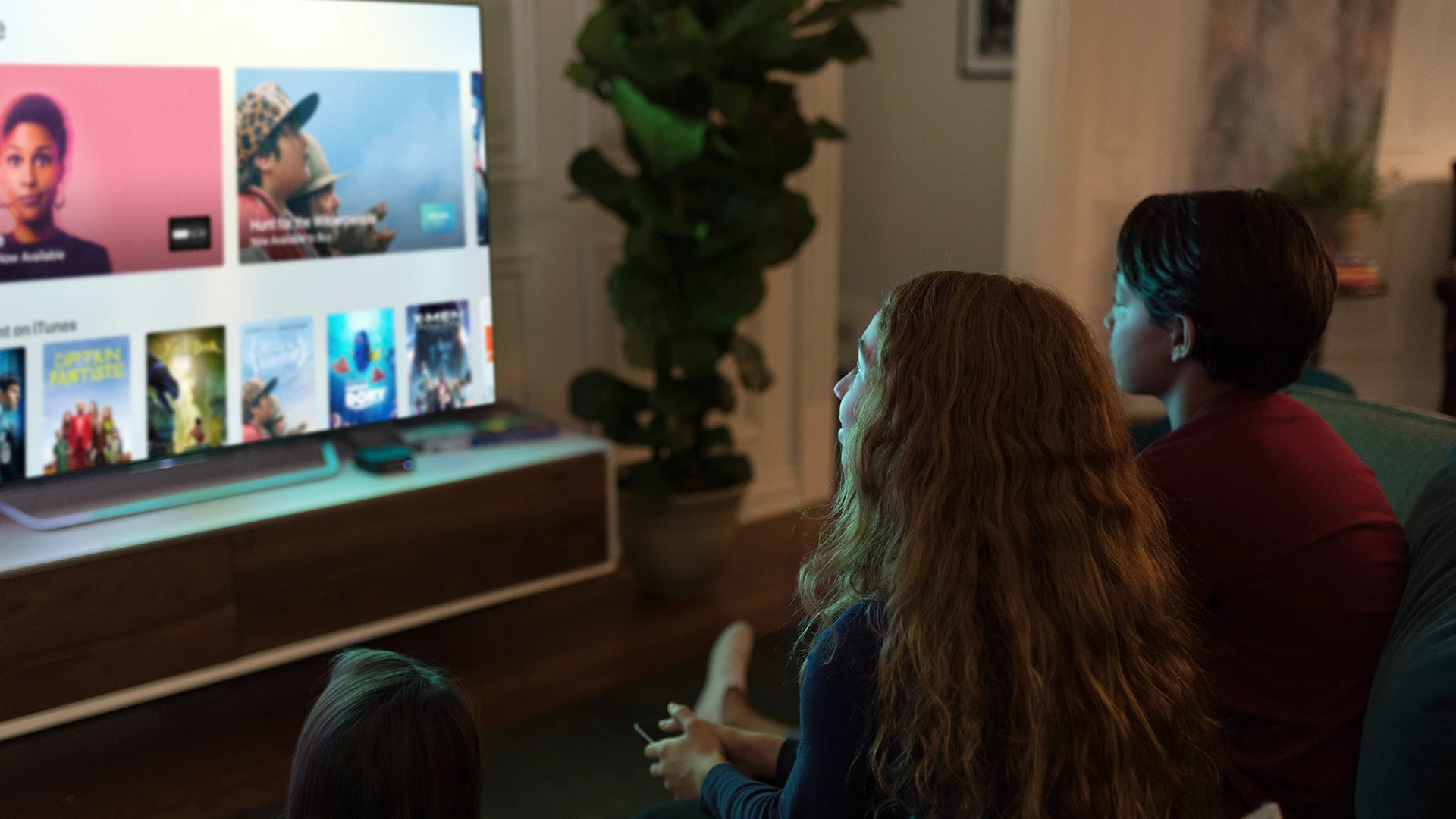When Raw Fury Games published its minimalist strategy game Kingdom: New Lands on iOS in January, creating an Apple TV version made sense. The iOS code was easy to port onto Apple’s set-top box, and the control scheme translated smoothly from the touch screen to the Siri Remote.
But five months after launch, Kingdom: New Lands has only sold about 600 units on Apple TV, versus 54,000 sales for the iOS version and about 35,000 sales for the Xbox One version that arrived about a year ago. Raw Fury cofounder and head of mobile Gordon Van Dyke hasn’t soured on the platform, but he says the publisher is unlikely to release any Apple TV games that it can’t easily port from existing iOS apps.
“If we were to only release this on Apple TV, it probably would have been a struggle,” he says.
Van Dyke’s comments exemplify Apple TV’s state of inertia as a video game system. Ever since Apple launched its fourth-generation TV box in late 2015, the gaming side of the platform has floated on without any clear direction or purpose. Developers say they have little incentive to create new games specifically with Apple TV in mind, so most games are iOS ports that are better enjoyed on an iPhone or iPad. The result is a game system trapped somewhere between success and failure. It’s an easy-to-ignore feature rather than a competitive advantage, one that Apple could really use as it bleeds market share among streaming boxes.
Apple isn’t the only company whose streaming box hasn’t made a mark on the gaming business. Amazon’s Fire TV and Google’s Android TV platforms are in a similar situation, and previous attempts at mobile-inspired gaming boxes, such as Ouya and GameStick, have been commercial flops.
In fairness, Apple has historically never placed a major emphasis on gaming. Still, the world’s most valuable company is in a unique position to do better. Its focus on high-end hardware potentially allows for better games than, say, an Amazon Fire TV Stick, and the company has a track record of rallying developers behind new devices like the iPad and Apple Watch. It also has the advantage of an enormous ecosystem with some of the most dedicated tech consumers. Some pundits even thought those advantages would help Apple TV take down the traditional game console business.
It’s not too late for Apple TV gaming to break free of its inertial state. But for that to happen, Apple would have to make a commitment to video games in a way that it never has before.

Remote Possibilities
In December 2015, not long after Apple TV launched, the device boasted 1,002 games, and gaming was by far the leading category in its App Store, according to Appfigures. Gaming on Apple TV has since grown by 170% to 2,704 games.
Still, that’s nothing compared to the hundreds of thousands of games in the iOS App Store, and on Apple TV the gaming category no longer leads. The Entertainment category has jumped ahead to 3,875 apps, growing by 830% over the past 20 months. And Apple TV’s Lifestyle category–whose apps include Nest, Zillow, and the Ikea Catalog–is closing in on gaming with 1,626 apps, for a growth rate of 1,080% since December 2015. As of this writing, the highest-ranked gaming title in Apple TV’s Top Free apps section is the road-crossing arcade game Crossy Road, at 28th place.
When developers do target Apple TV, sales aren’t always the primary motivation. Matt Small, the CEO of mobile game studio Vector Unit, says creating the TV ports helps the studio establish a strong relationship with the platforms’ gatekeepers. (Games like Riptide GP2 and Mousebot generate a bit more revenue per user on streaming boxes, he says, but overall they don’t sell nearly as well as their mobile counterparts.)
“Because it’s not too much work for us to port onto the TV platforms, it’s part of our ongoing good relationship, maintaining our relationship with Apple, with Google, to help support their new platforms coming out,” Small says.

Those ports also help add value to the iOS version of the game, says Raw Fury’s Gordon Van Dyke. Someone who’s thinking of getting Kingdom: New Lands on an iPhone, for instance, might be more inclined to buy if they know it’ll also work on Apple TV.
“Whether they play it or not, I don’t know, but at least they do know that when they bought Kingdom, if they ever got an Apple TV, and they wanted to play it, they have that as an option,” Van Dyke says.
Neither developer, however, is currently interested in bringing games to Apple TV that they can’t also launch on iPhones and iPads. And that ends up being a limiting factor.
Raw Fury, for instance, publishes a beautifully atmospheric platform shooter called GoNNER on PC and Nintendo Switch, and Nvidia also ported the game to its own Shield TV box with Raw Fury’s blessing. But the control scheme wouldn’t work with the minimalist Siri Remote, which only allows game controls on its directional pad, menu, and play/pause buttons. And while Apple TV supports third-party game controllers, Van Dyke isn’t comfortable requiring them to play.
“I don’t think a lot of people tend to buy additional input devices for their Apple TV, so if it can’t work with the Siri Remote, it kills our ability to bring it to the Apple TV,” he says.

Vector Unit’s Matt Small says that if his studio were to target Apple TV only, it could introduce new lighting effects and other graphical improvements that don’t exist in its mobile ports. The studio could also create games with more complex controls than what the Siri Remote allows, or experiment more with the Siri Remote’s motion controls, which he says are underutilized by developers.
But for now, those are only hypotheticals. “We would probably wait for the audience to get a little bit bigger” before doing an Apple TV-only game, Small says.

Rethinking An Apple TV Game Console
Eddy Cue, Apple’s senior vice president of software and services, told BuzzFeed in December 2015 that gaming on Apple TV would grow in the same way that it did on the iPhone.
“When we first announced the iPhone, we didn’t tout it as a gaming device,” Cue said. “But games became a huge part of iPhone, because it turns out that a lot more people than just hardcore gamers love games. We expanded the market.”
The current state of gaming on Apple TV proves that Cue’s prediction was wrong, and in hindsight it’s clear why: While the iPhone’s touch screen provided a new and intuitive way for anyone to play games, the Siri Remote is more cumbersome for games than either a touch screen or a proper game controller. And because the Apple TV’s games are mostly designed with iPhones and iPads in mind, playing them on the big screen isn’t necessarily a better experience. (Case in point: Vector Unit’s Mousebot is harder to play with the Siri remote’s tilt controls than with the touch screen buttons on an iPhone or iPad.)
Any improvement in Apple TV gaming, then, would have to start with a stronger stance from Apple on input devices. That’s not to say Apple should start bundling full-blown controllers with every set-top box, but it could redesign its remote in a way that’s more game-friendly. The Roku Ultra’s remote control, which has a directional pad at the top and two gaming buttons on the bottom end, is a great example of how to include basic game controls without compromising the remote’s other functions.
“I would like to see a few more buttons, to be honest, just to give us that flexibility where there’s optional buttons, maybe even on the underside of it . . . so that it almost feels like an NES controller,” Raw Fury’s Gordon Van Dyke says.

Apple could also take more ownership over games that use traditional controllers. Instead of just slapping a “Controller Required” warning on the App Store product page, as it does now, perhaps the company could detect whether the user has connected a controller to the system and tailor the App Store experience accordingly. At that point, an optional controller bundle from Apple might even make sense.
“If there was a way to ensure that people had these extra controllers, I think it could be really cool,” Van Dyke says. “It would make it easier for us, where we don’t have to worry about if someone buys this and they don’t have the input device to actually play it.”
Related: Apple TV will need more than 4K HDR to redeem itself
Finally, Apple could jump-start development and get people interested by funding some “only on Apple TV” games itself. The company isn’t above releasing its own novel apps–like iWork and GarageBand for iPad–when it wants to set expectations around a given platform. And with Apple reportedly earmarking $1 billion for original video next year, the notion of original game development doesn’t seem out of line. Some premium, exclusive games might even help Apple TV break out of the free-t0-play model that has arguably corrupted mobile gaming.
“You could certainly place a few bets for a lot less than a billion dollars,” Vector Unit’s Matt Small says.
The common thread with all these suggestions is commitment. Until now, Apple hasn’t put much effort behind Apple TV gaming—an echo of the company’s seeming attitude toward gaming in general—and Cue’s comments from December 2015 suggest this was intentional. While the hands-off approach might have worked for the iPhone and iPad, it’s not having the same effect for Apple’s living room box. Until gaming becomes more than an afterthought for Apple, it’ll remain an afterthought for its customers, and a source of apathy for its developers.
Recognize your brand’s excellence by applying to this year’s Brands That Matter Awards before the early-rate deadline, May 3.
